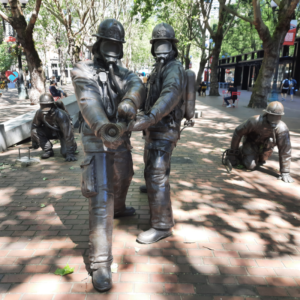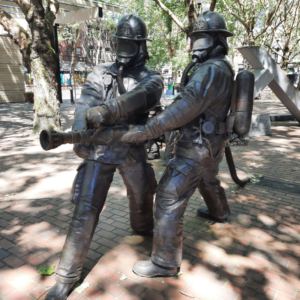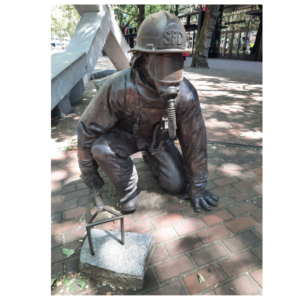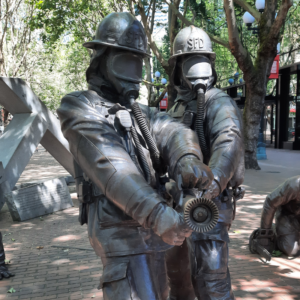05 Jan On This Day in History: 1995 Warehouse Fire Worst Tragedy in Seattle Fire Department History

While the Fallen Firefighters Memorial in Seattle’s Occidental Park was inspired by the four victims of the Pang Warehouse fire, the four bronze statues, created by artist Jason Wu Hai Ying, were erected to honor every Seattle Fire Department firefighter killed in the line of duty since the department’s founding in 1889. Names of the 49 fallen SFD firefighters are etched in granite near the bronze figures.
One man’s insatiable greed caused four firefighters to lose their lives while battling a warehouse fire in Seattle’s Chinatown International District on January 5, 1995. Martin Pang, the adopted son of Mary and Harry Pang, who owned the eponymously named Chinese frozen-food warehouse, lit the match that started the deadly five-alarm blaze. His motive was to collect the insurance payout for the warehouse, but instead, Martin Pang received a 35-year sentence for his avarice.
Having never quite found his professional footing other than pursuing acting and trying his hand at several failed entrepreneurial endeavors, Pang lived off revenue from Mary Pang’s food products which began to decline in the 1990s. As the Pang family’s financial empire dwindled, Martin lobbied for his parents to sell or redevelop the property; however, they weren’t interested.
For years, Pang had been telling friends, including his ex-wife Rise Johansen, about his intent to torch the warehouse to collect insurance money. He even shared with his ex-wife the dates of December 16-18, 1994, as the targeted timeframe for his arson attempt. Employed at the Pangs’ frozen food warehouse, Johansen shared this information with an insurance agent who reported the information to the Bureau of Alcohol, Tobacco, and Firearms (ATF).
On December 14, ATF agents interviewed Johansen, who shared a map of the warehouse to show authorities where Pang planned to set the fire. The ATF then informed the Seattle Fire Department (SFD) of Pang’s plot, which resulted in SFD and ATF agents surveilling the property throughout mid-December, but the dates Pang had targeted passed without activity. The ATF later ceased investigating, leaving the warehouse surveillance to the SFD’s arson squad, which ended in the final two weeks of December.
At approximately 7 p.m. on January 5, 1995, after receiving several 911 calls reporting smoke, seven fire companies, comprising 32 personnel, swiftly responded to the Pang warehouse. Battalion Chief Kem Hunter, serving as the acting head of the headquarters division and incident commander, promptly conducted a visual assessment or “size-up” of the warehouse. Observing three sides of the building, he initially perceived it as a single-story structure. Although he vaguely recalled reading about the Pangs’ warehouse in a December brief, he couldn’t recall specific details about the layout of the structure.
Due to the identity of the source, only a few fire officials and the arson squad knew that the warehouse was being targeted by Pang, so the arson information was not shared with those who would later battle the blaze. And despite SFD and ATF surveillance, SFD’s firefighting teams were not aware that the warehouse had a basement where Pang had stored car-racing supplies, including fuel and 3,000 to 4,000 pounds of cardboard.
While battling the warehouse blaze, firefighters initially believed it was contained to the main floor. The presence of a concrete layer on the basement floor misled them into thinking they were on the building’s lowest level. Despite this, the 12 firefighters inside sensed an unusually intense heat compared to their visual assessment. Lt. Gregory Shoemaker, realizing something was amiss, signaled his crew to evacuate, but the collapse of the floor occurred too swiftly.
Shoemaker, Lt. Walter Kilgore, and firefighters Randall Terlicker and James Brown plummeted 20 feet into the basement where they perished. Kilgore, Brown, and Terlicker tragically succumbed to asphyxiation when their air tanks emptied. Shoemaker, who lost his helmet and oxygen mask in the fall from the first floor, died of smoke inhalation.
After setting the fire, Pang fled to Brazil, where he could not be extradited. Brazilian officials refused to extradite Pang to face four first-degree murder charges for the deaths due to arson based on the legal distinction that the same crime in Brazil could not be prosecuted as murder.
After a three-year legal battle, Pang was returned to the U.S. after Seattle prosecutors agreed to charge him with four counts of first-degree manslaughter. After pleading guilty, Pang was sentenced to 35 years in prison. He spent 23 years in the Monroe Correctional Complex and later the Washington State Penitentiary before his release on September 27, 2018.
In the aftermath of the fire, lawsuits were filed by the families of the four deceased firefighters, and a state-imposed fine for safety violations was leveled against SFD. This resulted in the SFD implementing modifications to its policies and procedures. “These changes encompassed upgrades to equipment and the initiation of self-rescue training programs for firefighters,” explains Joe Chacon, PE, a senior fire protection engineer at TERPconsulting, who also serves as a firefighter and HazMat technician.
A United States Fire Administration (USFA) investigative report determined that the fire was deliberately started in the basement storage room, which measured 30 feet wide, 60 feet deep, approximately 20 feet high, and was heavily loaded with combustible products. The USFA technical report also noted that the crews at the Pang fire lacked critical information, such as the layout of the building and the fact that it had been the subject of arson threats. “Now fire crews are often equipped with building plans and receive advance alerts about potential hazards, including the risk of arson or the existence of explosive chemicals,” said Chacon, a principal member of the National Fire Protection Association (NFPA) 1620 — Recommended Practice for Pre-Incident Planning.
Ironically, NFPA 1620 was first issued in 1995. This standard provides guidelines and recommendations for conducting pre-incident planning to enhance the effectiveness of emergency response efforts in the event of a fire or other emergencies. The primary goal is to help fire departments and other emergency response organizations prepare for potential incidents by gathering and analyzing relevant information about buildings, occupancies, and the surrounding environment.
To honor the most significant loss of life in the history of the Seattle Fire Department, the Fallen Firefighters Memorial was established in Seattle’s Occidental Park in 1998. This memorial, featuring four bronze statues, pays homage not only to the tragic incident at the Pang Warehouse but also honors every SFD firefighter killed in the line of duty since the department’s founding in 1889. A year following the fire, Gary V. Medica, a firefighter who experienced a heart attack during the Pang fire, passed away. His name is engraved on the memorial in Occidental Square, alongside those of Kilgore, Shoemaker, Terlicker, and Brown.






No Comments